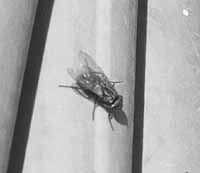| The common house fly pictured here on a hose handing in the sun is often confused with the cluster fly. |
If one has never seen Cluster Flies, one has not experienced one of the most disgusting displays of natural phenomena ever created by insects.
Often confused with the common House Fly, Cluster Flies are roughly the same size. Some characteristics that differentiate the Cluster Fly are that they fly somewhat more slowly than the House Fly, they almost always fly toward windows on the warm side of a structure, their wings overlap almost completely when at rest.
More importantly when they breed, they breed by the thousands even millions. Cluster Flies breed in the ground outside of buildings during the warm weather (late Spring into early Summer) using earthworms as a food source for the immature larva (maggots).The flies later pupate (go into the cocoon stage) and then later hatch as adult flies. In temperate areas, often in late August, these flies begins to migrate indoors finding any small cracks or crevices that permit entry into structures. These may include areas around window frames, door frames or eaves. Entry tends to be on the same, warm, sunny side (often the southern or western exposure) of the structure as the flies later emerge from.
During the Fall, Winter or Spring months, these flies may emerge – particularly on warm, sunny days. In Utah they tend to work their “magic” in the fall more than anytime. The flies appear at windows buzzing and “clustering” around those areas to the dismay of the occupants. This fly can become a problem in virtually any structure and they have, on occasion, been a problem in sensitive areas such as preschools and health care facilities where they are especially unwelcome guests.
Cluster Flies can be the worst of enemies by just existing. They don’t bite or sting, but their numbers are what cause them to become not only annoying, but a health risk. In some structures they can number into the millions under the right conditions. In a building full of cluster flies, two people talking with each other within what is normally a casual conversation distance may have to yell to each other to be heard over the din of the buzzing. They are also very aggressive by flying in peoples face and generally just bugging anyone who tries to sit down anywhere in the building. Eating with these flies around is almost impossible.
As they tend to cluster at windows with the sun on them they will move from one part of a building to another as the sun rotates along it’s autumn southern axis. In their wake they can leave large pools of droppings that will literally drip out of the window sills and down the walls. They carry the same kinds of diseases that commons house flies carry so the increased activity and inhabitation make it much more uncomfortable and risky to be in any structure that has them.
One of the best ways to minimize entry of this pest is by applying a repellent, residual insecticide within a week or two of the time when these insects are known to begin migrating indoors. These residual insecticides are applied outdoors to window frames, door frames, soffits and eaves as well as any other areas that are vulnerable to entry. Effective treatments basically barrier the structure from the insects so they will go somewhere else or die in the process.
Some experts suggest that application to the surrounding soil may also help minimize Cluster Fly populations and later entry, but others caution that since flies may come from other, adjacent areas, treating the soil is somewhat futile. Besides in many cases the kinds of insecticides that can be used within or on structures is not made to be applied on the soil. This often requires other kids of treatments the break down before it becomes dangerous to the environment.
Protection from the outside is the best answer, because one they are inside they are very difficult to remove completely. As long as a structure is warm inside a few will hang on no matter what.

